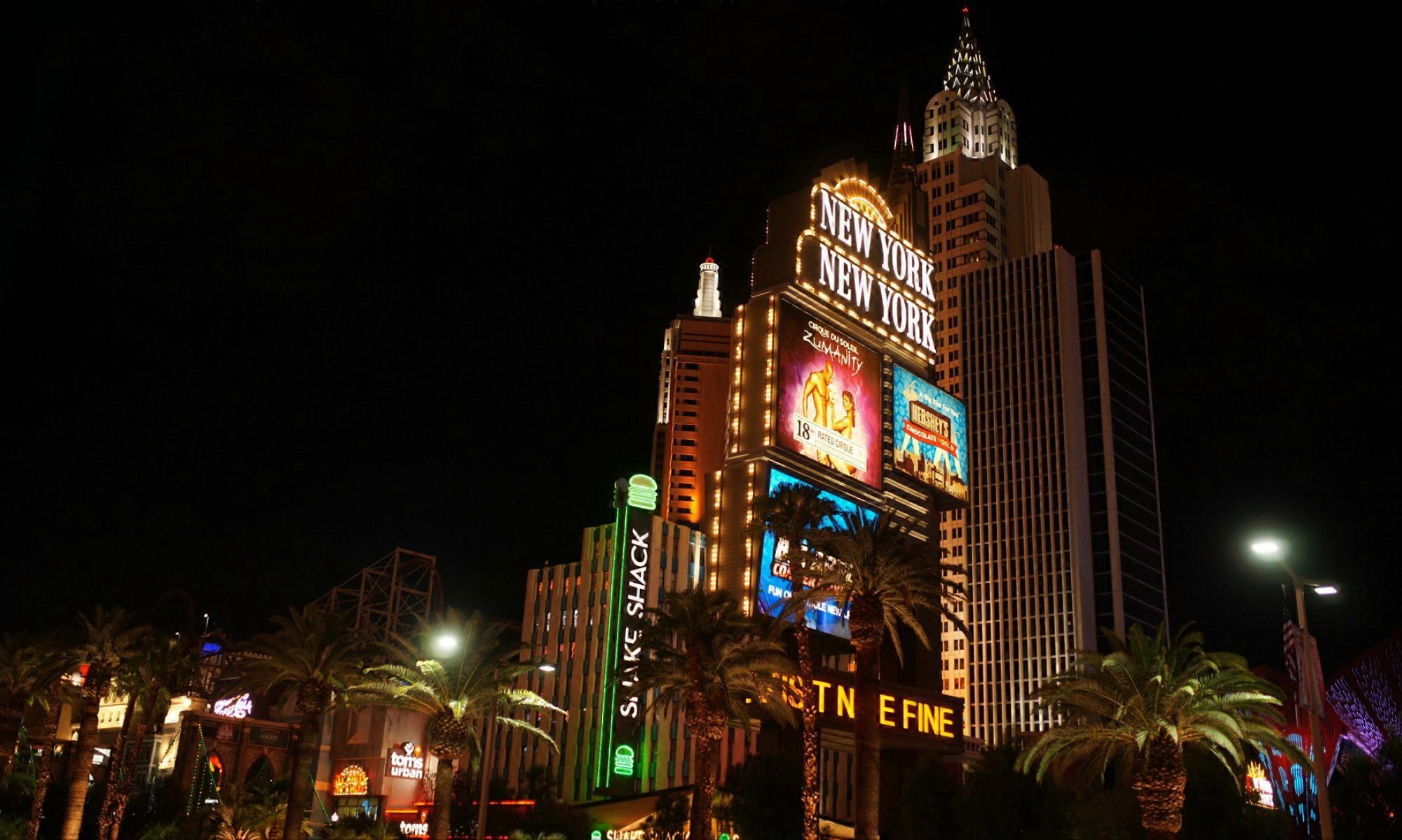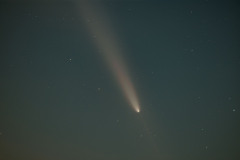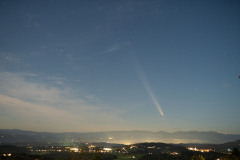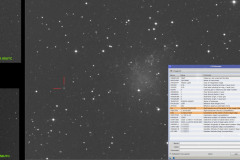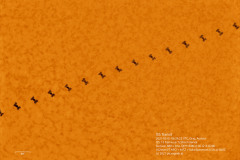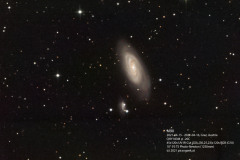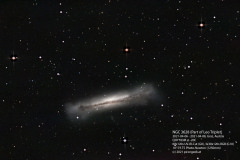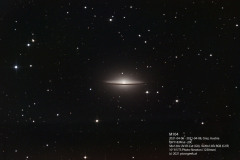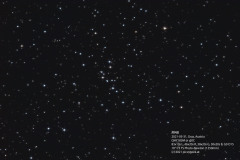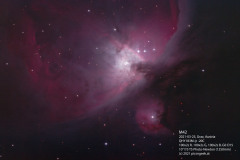Finally, the long awaited comet C2023/A3 Tsuchinschan-ATLAS reappeared after its passage close to the sun. With a well timed window between clouds, I could observe and image the comet. From all the announcements, I expected the comet to be brighter. But still, it is a naked eye comet to enjoy with a pretty long tail.
Thors Helmet (NGC 2359) second attempt
Back in 2021 I imaged and processed NGC 2359. The interesting features of this Wolf-Rayet nebula were quite nice, but the weaker parts were invisible: NGC 2359 – Thor’s Helmet in narrow band during Full-Moon
So i started a new imaging run with higher magnification (1320mm instead of 564mm) and more sensitive camera. The resulting image of almost 13 hours data shows a lot more of the surrounding and weak features, even though, the same imaging location was used. The same Bortle 6-7 location was used, observing low above the light cone of the city.
Image data:
Date: 2024-01-10 – 2024-01-27
Location: Graz, Austria
Telescope: TS 256mm f/5 Newtonian with 1.06x ES HR coma corrector (equals to 1320mm focal length)
Camera: QHY268M @ -10C
Filters: Optolong LRGB, Baader H-alpha, O-iii
Guiding: PHD2 off-axis guider (ASI485)
Exposures:
H-alpha: 30x600s
O-iii: 24x600s
L: 116x60s
R: 24x120s
G: 18x120s
B: 18x120s
Asteroid (140) Siwa close to IC1613?
ISS Transit in front of the sun
On Sunday, May 1st, I was lucky to have the ISS transit the sun only a few kilometers away. Weather played with my plans as well. So i packed my solar scope and drove to a place right in the center of the transit line.
The transit itself is a very brief event. This particular one lasted for less than 2 seconds. So everything hat to be well set up before the clock reached 08:24:22 CEST.
This image is a combination of 15 individual images captured in 1.02 seconds. The solar surface was further enhanced by a stack of 880 frames adjacent to the transit itself.
M90 Galaxy
This is my first image of Messier 90. It is not yet as good as I would like it to be. Which is due to bad weather preventing further imaging. As the moon is already too bright, I will have to postpone further imaging at least to the next new-moon phase.
Nevertheless, this image shows already a beautiful spiral galaxy with its companion.
Image data:
Date: 2021-04-15 – 2021-04-16
Location: Graz, Austria
Telescope: 10″ f/5 Newtonian with GPU corrector (1250mm focal length)
Camera: QHY183M @ -20C
Filters: Optolong RGB + Baader UV-IR-Cut
Guiding: MGEN-II with off-axis guider
Exposures:
UV-IR-Cut: 45x120s, Gain 0, Offset 15
R 30x120s, G 25x120s, B 23x120s, Gain 10, Offset 15
NGC 3628 – Galaxy in Leo Triplet
This is the third and dimmest galaxy of the Leo Triplet. The other two galaxies M65 and M66 are quite close, but did not fit in the image. They seem to be not only close in our view. The three galaxies might interact in gravitational forces.
The dust band in front of the edge on view of the galaxy render it a very interesting and beautiful deep sky target.
Image data:
Date: 2021-04-04 – 2021-04-08
Location: Graz, Austria
Telescope: 10″ f/5 Newtonian with GPU corrector (1250mm focal length)
Camera: QHY183M @ -20C
Filters: Optolong RGB + Baader UV-IR-Cut
Guiding: MGEN-II with off-axis guider
Exposures:
UV-IR-Cut: 60x120s, Gain 0, Offset 15
R, G, B: 30x120s, Gain 10, Offset 15
M104 – The Sombrero Galaxy
M104 is one of the deep sky objects, I could capture during the past week of clear nights. M104 is a rather difficult target for my balcony imaging, as it stays quite low. So the influence of the air movements cauesed by the city, I am looking over, is significantly increasing stars and reducing detail in the galaxy.
Apart from detail level – this 4 hours worth of imaging goes deep enough to clearly show at least 4 small and faint galaxies around M104. The faintest being at 17.9mag.
Image data:
Date: 2021-04-04 – 2021-04-08
Location: Graz, Austria
Telescope: 10″ f/5 Newtonian with GPU corrector (1250mm focal length)
Camera: QHY183M @ -20C
Filters: Optolong RGB + Baader UV-IR-Cut
Guiding: MGEN-II with off-axis guider
Exposures:
UV-IR-Cut: 58x120s, Gain 0, Offset 15
R, G, B: 20x120s, Gain 10, Offset 15
Project: Messier catalog from Bortle 6 home
After several months struggle with my 10 inch Newtonian telescope, I got all configured properly. Camera, Auto-Guider, APT, etc. are well tuned to produce nice and round stars, even in several minutes long exposures.
I am unable to view or image the whole sky from my balcony setup. I may only point to an area within 80 to 220 degrees azimuth (south-east to west-south-west) and an altitude from 12 degrees to at most 70 degrees. In several occasions, this is truly a very limited view, when objects are only visible for short periods. But still, my view is facing south. So over the course of one year, the majority of the well known deep sky objects are passing by. And for the rest of the sky, I will find opportunities to drive an hour to one of my mountain observing spots with Bortle 3-4 skies 🙂
Living on the northern edge of a city with a south-facing view is by far not a good combination for astronomy or astro-photography. Fortunately, the city I live in, is not too large. Therefore, my average night (if the sky is free from clouds), provides a Bortle 5-6 sky (most of the time 19.3 to 19.5 magnitues per square arc second). Visually, I have a hard time enjoying anything apart from the brightest objects. But imaging delivers really pleasing results.
During the last weeks of testing and imaging, I grew the idea to create my own Messier Object images catalog, where almost all images are recorded from this one location, with all its drawbacks. By pursuing this project, I want to show, that astronomy as well as astro-photography are still possible, even though light pollution gives us a hard time…
See the results, as I progress here: My Messier catalog from Bortle 6 suburban home
M48 and M65+M66 – finally with round stars
The past months I had trouble with my 10 inch scope. I was not able to image with nice round stars. So i kept imaging with my smaller refractor, as stars were rendered round. After some investigation and chat with fellow astronomy club members, I could nail down the cause of the elongated and triangular stars: the auto-guider as well as a too short settle time after dithering were messing up. So, to achieve the round stars everyone is after, I had to increase the settle time after dithering (otherwise, I got double-images due to the offset) as well as the guiding parameters in MGEN. My settings for off-axis guiding on 1250mm focal length are: Threshold: 0.1, Aggressivness: 100% in RA and 80% in DEC and 2×2 binning.
The first test target was M48 with 50% aggressiveness. Stars were not yet fine. The second target was M65 together with M66. Stars are fine!
Image data:
Date: 2021-03-31
Location: Graz, Austria
Telescope: 10″ f/5 Newtonian with GPU corrector (1250mm focal length)
Camera: QHY183M @ -20C
Filters: Optolong RGB
Guiding: MGEN-II with off-axis guider
Exposures:
M48: 83x10s L, 46x20s R, 30x20s G, 30x20s B
M65+M66: 48x60s L, 39x60s R, 32x60s G, 20x60s B
M42 with short 2 second exposures
It is amazing what modern cameras are capable of! Intreagued by learning how to improve the quality of deep sky astro photography, I stumbled upon Dr. Robin Glovers talk and essay on picking the correct exposure settings. Dr. Robin Glover is the creator of SharpCap, which is one of the best recording tools for planetary imaging.
A head full with new wisdom, I tested for myself, how true the statements according image aquisition were. Therefore I selected the core of M42 – around the trapezium – to set all parameters to. Using my 10″ f/5 newtonian telescope, I could set only a mind buggling 2 second exposure length, before saturating the 4 stars. I expected to gain a little bit of nebulosity, as the area around the trapezium is really bright. But what I could gain in post processing the 300 individual exposures is simply fantastic! Compare the 2 images attached – the nearly black one is one of the individual frames used to create the colorful result!
Image data:
Date: 2021-03-25
Location: Graz, Austria
Telescope: 10″ f/5 Newtonian with GPU corrector (1250mm focal length)
Camera: QHY183M @ -20C
Filters: Optolong RGB
Guiding: MGEN-II with off-axis guider
Exposures:
100x2s R, 100x2s G, 100x2s B
